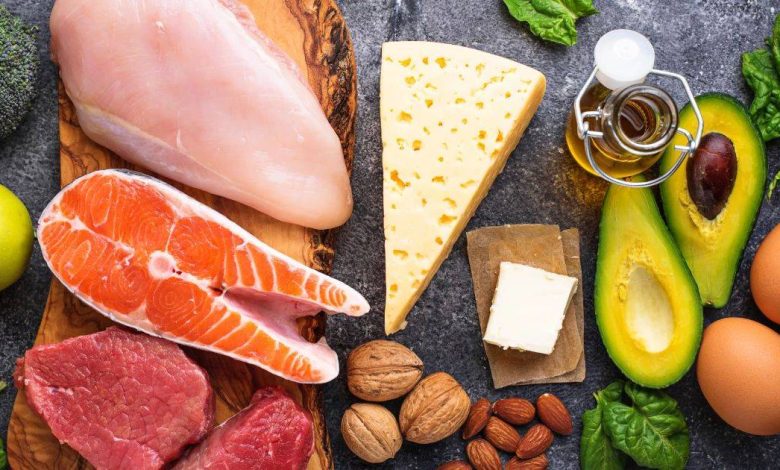High-fiber, low-carb diet: how to burn belly fat 28 days

The benefits of a low-carb diet have been well studied.. But this method has a drawback: along with low carbohydrate intake, fiber intake is reduced. Both products are important for the body. New diet combines the benefits of low-carb and high-fiber diets.
The low content of carbohydrates in products in the modern world has a positive effect on the body. This is evidenced by more 100 000 scientific articles in knowledge bases, not counting popular scientific articles from newspapers and magazines. But the more we reduce carbohydrate intake, the less we consume sources of fiber, such as whole grains and legumes.
How fiber is good for the body
Fiber is important for the body, because it lingers in the stomach, swells and increases the volume of food. This contributes to a longer feeling of fullness.. Prolonged stay of food in the stomach inhibits ghrelin, appetite hormone.
Fiber also dilutes carbohydrates and sugars in the gut, and they enter the blood more slowly. They also mechanically clean the tooth surface., which reduces the risk of caries.
New product combination: low carbs, a lot of fiber
High fiber carbohydrate combination is new. The low-carb, high-fiber diet eliminates the only known downside of the famous low-carb diet.
The benefits of a low-carbohydrate diet continue - for example, then, that it supports the breakdown of fats much better, than other diets. It especially affects visceral belly fat, which is deposited around the internal organs and is especially dangerous.
Thomas Kurscheid, nutrition and sports medicine specialist, developed a 28 day diet, based on everyday recipes from food journalist Bettina Mattei.
Phase 1
The first days are only allowed 20 grams of carbohydrates per day, from the fourth day 30 grams, but you can eat more protein in the form of fish, meat, eggs, soybeans, tofu cheese.
Salads and vegetables are also allowed in larger quantities. AND, of course, fats and oils. If you used to eat a lot of carbohydrates, especially sugar, you may notice something like sugar deficiency within two to three days. In this phase, sugar reserves (glycogen), spent and never replenished.
At first it may seem, that you don't feel well, but this state of affairs is rapidly changing. You will also quickly lose two kilograms of water., associated with glycogen.
1 day
Choose low-carb breakfast and lunch recipes. First day, it is recommended to skip dinner or just eat a salad with a very small piece of meat or some fish.
2-Day
First of all, drink one or two glasses of non-carbonated water.. It stimulates blood circulation and digestion. If you like to play sports, a session of exercise on an empty stomach will be a good way to further deplete glycogen stores. Or you can just take a walk. Do not be surprised, your performance at this stage may be lower than usual, you will feel tired! Prepare low carb meals and keep an eye on your overall carb balance (preferably from 20 to 25 grams per day) and fiber (to 25 grams, depending on the degree of addiction).
3-Day
Primarily, drink water again. Exercise before breakfast. Glycogen stores are now almost depleted. Performance may decrease again. But these days the ketosis engine is slowly starting (the body begins to break down fat for energy with the formation of a large number of ketone bodies).
4-14 day
From the fourth day, working capacity usually returns, often stronger, than before the diet. That's exactly the goal! To maintain ketosis, it is important not to exceed 25-30 grams of carbohydrates. Don't Overdo Protein (ie. don't eat huge portions of meat, fish, tofu etc.), because the body can produce carbohydrates from them.
Due to the long-term effect of satiety, many people on this diet switch to two meals a day after a few days.. This is the optimal meal frequency, but three meals is fine too. Always consume less 30 g carbs per day!
Phase 2
14-and on the 28th day
Now the metabolism continues to be moderately ketogenic: in this phase, carbohydrate intake can be slightly increased with 25-30 grams to maximum 50 grams of carbohydrates per day. Be Consistent, so you don't have to start over.
Basic rules for both phases
- Only use products, containing less 5 grams of carbohydrates per 100 grams.
- Don't Overdo Protein. 80-a pound man can consume up to 160 grams of protein, especially if he's athletic. Better and tastier to meet protein needs from different sources, i.e. chicken, fish, tofu.
- Eat so many fatty foods, until you really feel full. It, of course, uneasy after brainwashing with low-fat diets. But don't worry, it won't make you gain weight. You can use fats and oils, containing mixtures of saturated and unsaturated fats, such as rapeseed oil, extra virgin olive oil, linseed oil and butter.
Phase 3
Flexible carbs are ideal for the long term. Permanently severe reduction in carbohydrate intake is not required..
To keep low carb diet relapses as low as possible, adjust the amount of carbohydrates according to weight and physical activity. When target weight is reached, and regular exercise will become a part of your life, you can start eating more carbohydrates again.
